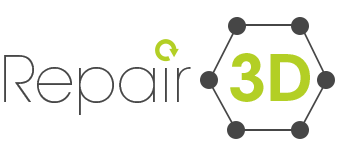Leadership in enabling and industrial technologies - NMP - Repair 3D
Introduction
Repair3D project aims at the development of innovative reclamation and repurposing routes for end-of-life plastic and carbon fibre reinforced polymer (CFRP) components. This will be achieved by employing advanced nanotechnology solutions, Additive Manufacturing (AM) and recycled resources, for the production of high added value 3D printed products with advanced functionalities. In this way, the combination of AM with Design for and from Recycling could constitute a new paradigm of a distributed recycling process, easily implemented at local scale in collaboration with the industrial sector and collection facilities. This approach can offer competitive, highly customisable products at lower production costs, in a flexible digital environment that fully unravels the potential of eco-design and allows for the integration of smart self-sensing, self-repairing and recycling-by-design features. Repair3D aims to address all aspects and stages of thermoplastic and CFRP reclamation, recycling and conversion through AM to new products, starting with the selection of suitable waste streams, strategies for material upcycling, reinforcement with Carbon Fibres (CFs) before, during and after AM.
Project description
The strategic goal of the research is to provide the frame (build the know-how, develop the technology, rise efficiency, assess properties and performances, investigate the domain of applicability and limitations), which will create new pathways for recycling of polymers and CFRPs for multiple processing life cycles, and explore the emerging valorisation opportunities in various sectors.
This goal is motivated by the limitations that currently exist in the development of technologies for reducing plastic and CFRP waste accumulating in the landfills, which have to be acceptable from the environmental standpoint and cost-effective, targeting the inherent complexities in separation and reuse of the constituents. Establishing innovative processes for recycling and multiple reprocessing of plastic materials thus remains a worldwide challenge. Furthermore, the development of new sets of sustainable and performant AM materials and methods for automated manufacturing of CFRP products as the output of the 3D printing process, hold the promise of becoming the next-generation fabrication methodology of freeform composites. In this respect, the proposed research will investigate on the possibilities and methods of obtaining 3D printed composite parts from upcycled resources, with built-in recycling-by-design features, while fully exploiting AM design flexibility to improve performance and incorporate smart features.
Objectives
These are the objectives of Repair 3D:
- Objective 1: Recycling and upgrade of selected thermoplastic (TP) waste streams. Mechanical recycling will be employed for various waste streams deriving from post-industrial waste and the rigid packaging sector, employed in extrusion, thermoforming, injection moulding processes. This will involve all steps required for pre-treatment, shredding and compounding, to modify the recyclates’ properties to meet the requirements of AM processing. Additionally, synergetic restabilisation systems (tailored for each polymer group) for stability against degradation during multiple reprocessing cycles will be employed.
- Objective 2: Reclamation and surface modification of recycled CFs (rCFs) and virgin CFs (vCFs) towards EOL separation and reuse. Chemical recycling via supercritical solvolysis to obtain clean CFs and valuable organic parts will be employed for CFRPs waste streams (post-industrial waste, out-of-date CFRPs components). Surface modification of rCFs and continuous vCFs tows via supercritical fluid (SCF) media and Roll-to-Roll (R2R) wet chemical treatment, for functionalization and coating with sizing agents doped with magnetic NPs, to induce tuneable adhesion to polymeric matrices for EOL separation and reuse.
- Objective 3: Comparative assessment of AM thermoplastic processing technologies. The sets of thermoplastic matrices and CF reinforcements developed will be assessed on their processability and performance for selected AM processes, with high versatility in processing a wide range of polymer grades and composite materials. Printability assessment and optimisation will be carried out, with emphasis on fabrication strategies to alleviate thermomechanical degradation during AM processing.
- Objective 4: Development of sustainable, high performance thermoplastic CFRPs with recycling-by-design and smart-by-architecture features. Repair3D project will fully exploit design flexibility and ease of multi-material integration of AM, to re-design and fabricate products from upcycled composite materials, with equal or better performance compared to commercially available products produced by virgin (composite) materials and conventional manufacturing methods. Apart from CF reinforcement, performance enhancement will be achieved by topological optimisation, material/weight reduction and efficient stress distribution.
- Objective 5: Demonstration of the circular use of the constituent materials through separation and reprocessing of AM produced parts. In the second phase of Repair3D project, the introduced recycling-by-design features and the proposed strategies for EOL separation and reuse of CFs and TP materials will be tested and assessed on their performance. A full LCA study on the recycling and conversion operations over the entire lifecycle will be conducted, including economical assessment.
- Repair3D also proposes two Industrial Objectives (INOs) to demonstrate the success of Repair3D materials, technologies and confirm the achievement of the targeted TRL 5: (i) Case studies for industrial demonstrators and ii) development of a business plan for projects results, targeting a new paradigm of a distributed recycling process.
Role of Ghent University
Ghent University coordinates the recycling and upgrade of selected thermoplastic (TP) waste streams and focusses on the filament, pellet and continuous fibre reinforced Additive Manufacturing methodologies including both material innovation, processing, equipment development and AM design strategies.
Website
Contact
Prof. Ludwig Cardon
Prof. Dagmar D’hooge
Prof. Karen De Clerck
Department Materials, Textiles and Chemical Engineering
Phone number: +32 9 331 0391
E-mail
